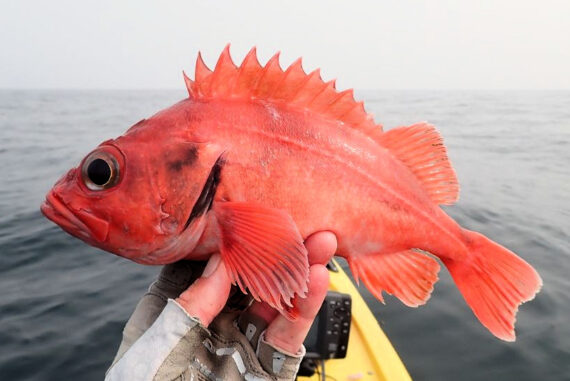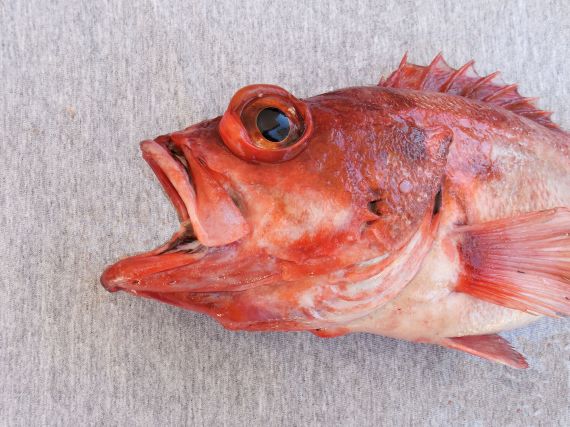Blackgill Rockfish, Sebastes melanostomus
 Blackgill Rockfish, Sebastes melanostomus. Fish caught from coastal waters off San Pedro, California, September 2020. Length: 26 cm (10 inches). Catch, photograph and identification courtesy of Ben Cantrell, San Diego, California.
Blackgill Rockfish, Sebastes melanostomus. Fish caught from coastal waters off San Pedro, California, September 2020. Length: 26 cm (10 inches). Catch, photograph and identification courtesy of Ben Cantrell, San Diego, California.
 Blackgill Rockfish, Sebastes melanostomus. Fish provided by the commercial fishermen of the greater San Diego area, San Diego, California, October 2014. Length: 37 cm (15 inches).
Blackgill Rockfish, Sebastes melanostomus. Fish provided by the commercial fishermen of the greater San Diego area, San Diego, California, October 2014. Length: 37 cm (15 inches).
The Blackgill Rockfish, Sebastes melanostomus, is a member of in the Rockfish and Scorpionfish or Scorpaenidae Family, that is known in Mexico as rocote agalla negra. Globally, there are one hundred eight species in the genus Sebastes, of which fifty-three are found in Mexican waters, all in the Pacific Ocean.
The Blackgill Rockfish is spiny fish with an enormous sloping head that continues into the mid-section and then tapers quickly to a thin tail. Their body depth is 34% to 38% of standard length. They have a red coloration with darker areas and white blotches. The gill covers have black margins for which they are named. Their clear lateral line becomes less apparent with maturity. Their fins and fin margins are similar in color to the body but with blank tinges. They have a disproportionately large head, large eyes, and a large terminal mouth. Their anal fin has 3 spines and 6 to 8 rays; their caudal fin is slightly lunate; their dorsal fin has 13 spines and 12 to 15 rays; and, their pectoral fins have 17 to 20 rays. They have 27 to 35 gill rakers and their body is covered with scales.
The Blackgill Rockfish is a demersal species that is found as solitary individuals or in small groups within boulders and rocky habitat at depths between 88 m (290 feet) and 770 m (2,520 feet). They are normally found mixed in with Black Rockfish. They reach a maximum of 61 cm (2 feet 0 inches) in length, with females being larger than males. As of January 1, 2024, the International Game Fish Association world record stood at 3.53 kg (7 lbs 12 oz) with the fish caught in coastal waters off San Clemente Island, California, December 2000. They feed on small fish, primarily lanternfish. Reproduction is oviparous with each female releasing between 152,000 and 769,000 pelagic eggs. They have lifespans of eighty-seven years. The Blackgill Rockfish is poorly studied with very limited information available about their lifestyle and behavioral patterns including specific details on age, growth, longevity, movement patterns, diet, habitat use, and reproduction.
The Blackgill Rockfish is a resident of Mexican waters of the Pacific but has a very limited distribution being found from Cedros Island, Baja California, northward along the central and northwest coasts of Baja.
The Blackgill Rockfish is fairly easy to identify when the black margins are present on its gill covers. When these are absent, it can be confused with the Darkblotched Rockfish, Sebastes crameri (5 dark blotches above lateral line).
From a conservation perspective the Blackgill Rockfish has not been formally evaluated. They are a strong component of the commercially fishery in coastal California waters with fish taken via both horizontal and vertical longlines and via trawls. They are sold in Asian markets in Southern California. Historically they were caught with some regularity by recreational fishermen but due to overfishing and lack of conservation their populations have been drastically depleted and they are now seldom caught by recreational fishermen.
